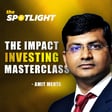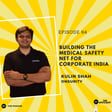Become a Creator today!Start creating today - Share your story with the world!
Start for free
00:00:00
00:00:01

Creating Water From Thin Air | Swapnil Shrivastav @ Uravu Labs
Water is an industry ripe for innovation and requires game-changing technologies to ensure a sustainable and better future for all. Uravu Labs literally creates water out of thin air. Swapnil talks about the journey of building the technology stack to make it possible and the business opportunities they are chasing. Listen on to this insightful conversation about building a deep-tech startup in India
What you must not miss:-
- The technology behind Uravu Labs.
- Challenges faced.
- Managing costs.
Transcript
Introduction to Uravulabs and Water Scarcity Context
00:00:00
Speaker
Hi everyone, this is Soukmel, Go founder of Uravulabs. We are a Bangalore based startup and we are working towards 100% renewable water solution.
00:00:20
Speaker
Water, water everywhere and not a drop to drink. These lines were written in 1834 and I'm sure the author had no clue about the climate change then. But these lines perfectly describe what is going to happen to us as a result of climate change. But don't lose hope yet.
00:00:36
Speaker
There are disruptive startups working to prevent this apocalypse.
Inspiration and Early Innovations in Water Solutions
00:00:40
Speaker
In this episode of the Spotlight Podcast, your host Akshay Dutt is talking with Swapnil Srivastav, the co-founder of the green tech startup Uravulabs. Uravulabs literally creates water out of thin air. And in this conversation, Swapnil talks about the journey of building the technology stack to make it possible and the business opportunities they are chasing. Listen on to this insightful conversation about building a deep tech startup in India.
00:01:13
Speaker
So as always being very much interested in water design, as well as product innovations, which are mostly focused on sustainability. So there was always one, you can say a topic in mind that things have to become more sustainable, things have to become more efficient in the future. So there were many, you can say.
00:01:35
Speaker
People who I look up to, one of them being designers like Buckminster Fuller. Then there have been people like Nikola Tesla. So these were the people who were really inspiring and they were always pushing the boundaries of what to do next, what to do next.
00:01:51
Speaker
So water was one element which caught my eye and that may be also because I've been swimming from the age of 6. So there was one thing I really like compared to any other sport I can swim for all day if I want to. Because that's something that's very pleasurable as well as enjoyable.
00:02:10
Speaker
So, there was always self-love affair with water in some way or the other. So, what happened then in 2013, while I was pursuing my architecture degree, there was one competition called Imagining the Future of Water and City.
00:02:24
Speaker
So that was like a global competition and there was like some good prize money of I think 20
Influences and Initial Experiments in Water Capture
00:02:30
Speaker
-30 thousand dollars. So we thought me and some of my friends thought let's just spend our summer breaks doing this and we participated in that. We started exploring what all has happened in the water sector and what are new technologies have come up in the past 250 years.
00:02:47
Speaker
So, we realized that the last major breakthrough which happened in the water sector was the reverse osmosis technology which came out in the 1960s.
00:02:56
Speaker
So, for the last 50 years, there was nothing major which has happened in the water sector in terms of new technologies. So, when we got this opportunity which said explore what would be the future of water in the city, we went totally futuristic and we suggested water from air could be one solution. And how I knew about water from air is again from
00:03:18
Speaker
science fiction your star wars has this on their desert planet katuni they have these moisture capture units so they were called as gx-8 and so that's how they got water in their desert planet of tatulu because there was no other water source so that was the one of the inspirations to just come up with okay water from air could be a thing and i think star wars was like it turned into a tube
00:03:48
Speaker
There's a planet. Yeah. So even in June, I had read in June 2010, before going to college, and Frank Herbert has this contractions like from the whole body moisture. And if you have seen the movie... I did like the movie, but I have a big fan of the book. The movie didn't do justice to the book. Maybe they'll pick it up later.
00:04:15
Speaker
So, what is a major thing was there in science fiction. And then when we started researching, then companies were already doing it. It was not something that no one has done yet or it's a totally vague concept, which has only happened. But it was only like in a very initial phases, someone has tried out in many ways. So, mostly the common technology or we can say the conventional technology to do this is to use an air conditioner kind of device and keep on condensing the water vapor in the air.
00:04:43
Speaker
So, what happens is whatever water vapour or humidity moisture is in the air, it will go, it will condense, it will cool down to less than 45 degree Celsius and will liquefy to liquid water. So, that's how the conventional process is.
00:04:59
Speaker
and when i was working on this combination that's what we proposed and but the our idea was that it could be part of a floating balloons in the sky because at the much higher heights you will have access to more air and you can cover it all the whole that floating balloon with a solar panel and drive the energy and moisture from there then just pipe it down to your house
00:05:21
Speaker
So that was just the initial idea and I thought that was a bit childish. But then that's what we submitted and then after some time we didn't get selected for the finals but that was idea was stuck in my then in 2015 I was going for my internship.
00:05:38
Speaker
So compulsory last year six months is an internship and then thesis. So for internship also I again chose a place in Bangalore where a person fall. He's like a groundwater expert in India and
Challenges and Learning from Experiences
00:05:50
Speaker
he was like looking at how to make our buildings or neighborhoods more sustainable through rainwater harvesting.
00:05:58
Speaker
Rainwater harvesting was one process and second was also wastewater treatment so that you can build self-sufficiency in a house or in a neighborhood and you don't have to rely on groundwater or in stanker waters which usually sees the brain in some longer distances.
00:06:13
Speaker
And even if you just take the case of Bangalore, we get water from Kaveri river, which is around 200 kilometers away. It's a long process, which involves a lot of pumping and energy wastage. But rather than that, you can have a solution which is much more decentralized and at your house. So that was again inspiring for me in the sense that you can do something which is more decentralized. You can do something which is very different from the infrastructure which has existed in the past 100, 160, 200 years.
00:06:44
Speaker
So then I took upon that as my thesis also where we were looking at how to do wastewater treatment using biological plants and not rely on reverse osmosis kind of processes which actually waste a lot of water. So for every one liter of water you purify you will get a 1.5 to 2 liters of wastewater.
00:07:03
Speaker
So that was again like close of my thesis and then I was wondering whether to pursue master's or layout something with the ideas I have about water and new technologies which would see actually. So I took the third option and then during my last semester in college, there was one more event which further inspired me to do that step and continue working on new ideas I had.
00:07:28
Speaker
So that was that in Canada, it usually rains a lot more. Six months, you'll have very heavy rains and then six months of summers. But during the last semester in 2016, we had a severe, let's say a drought.
00:07:41
Speaker
in our college campus in that area. So, what had happened is, has let right soil. So, groundwater retention is very bad. So, even if it drains a lot, almost all of it drains to the sea very quickly. So, you have to rely on surface water bodies, either rivers or lakes. So, the river which supply water to our college campus had dried up from the months of January to March, I don't think.
00:08:02
Speaker
So, we had to rely on these tanker water coming to our foliage and there was always a rationing, you will get one bucket per day, kind of. So, that was a situation I realized or even in a place like Calicut with rains or not. Our infrastructure is not designed to adapt and be resilient to all these changes we have. And throughout,
00:08:24
Speaker
The college life, I had worked with some art and design professors and based on my interaction and my work on that, I was also fourth in a book called E-Defocracy for Smart Cities. So there also we had taken up how design could adapt to all these changing, either the changing climate or changing weather. So that was again a point of which, which kind of held me to, okay, you can go out and do something.
00:08:53
Speaker
build something new. So I started working on this water from here and set during my last semester in college. And with me was my batch suite. So we thought, okay, this is some new ideas, which we can just take up and start work towards.
00:09:11
Speaker
So the first device we created was actually the conventional one. We just took a compressor, or instead of a compressor, it's like a PCA device, which again gives us the same, creates a mini port surface, and you can pass it over there. So that was one of the first experiments just to tell ourselves that, okay, this works. It's not something that you just read about, but it's something which works. That was the first of our experiments, and we thought, okay, let's further give it a try. We'll do a part 9
Developing and Scaling Water from Air Technology
00:09:40
Speaker
and see what happens.
00:09:41
Speaker
So, then postal college, we just somehow landed in Bangalore everywhere and we thought we'll keep on working towards that. Pylos are also doing some freelance works with design, sub-chatter companies, just helping them out. But on the free time, we were also building. So, first we built like a 50-litre unit and then we even worked about half a year to build 200 litres per day with the conventional VF and machine technology.
00:10:10
Speaker
So in a way we didn't, how would this work? Just describe this 200 liter unit, like what did it look like? So how it works is there will be a compressor, which we usually use in conditioners or refrigerators, and there will be a refrigerant which passes to a heat exchanger. So when you run this compressor at some certain operating conditions, the heat exchanger will turn to almost 4 to 60 degrees Celsius temperature. And over this heat exchanger, you will pass ambient air.
00:10:40
Speaker
So you can, ambient air needs air all around us with abnormal temperatures. So when you pass this ambient air over it, there'll be a certain temperature where the moisture in the air will start connecting to liquid water.
00:10:53
Speaker
So that's the basic process and they're almost 190 plus companies all over the world, which do exactly the same. This is like commercial grade technology right now. People are using this technology for water. Correct. So it's basically an air conditioner, but you can describe it. I describe it as an air conditioner of steroids. You actually take more energy and just keep on condensing that work.
00:11:18
Speaker
With that cool layer which is coming out, that is wishful. It's not kissy because I've got it now. So some people have tried in that way also. They'll use that layer to fasten to the room also. Or you can again use that cool layer to cool the incoming ambient air to make the system 5% more efficient. So we tried all those results. So we actually started with a non-readable option for all regards compared to what we are doing today.
00:11:46
Speaker
And this would be very energy inefficient. Maybe you would consume X number of watts for every one liter. What was that X number? How many watts would you consume? We had made our first unit and Bangalore conditions were relatively around 60-70%. So it consumed around 400 watt hours per liter, almost 0.4 units.
00:12:07
Speaker
which is not sustainable from a pricing perspective also as well as if you look at the day today also 60 to 80 percent of that comes from fossil fuel based power plants. So for every meter of water you produce you will be ejecting around 100 to 500 grams of fuel.
00:12:24
Speaker
So, it's going in the opposite direction towards what you have to do. And the other problem we found was whenever RH conditions say drop below 50%, this power consumption RH drops relatively quickly. So, it's actually a specific amount of water is there, divided by the specific amount of water is there at conditions when it can condensate.
00:12:48
Speaker
So usually it's a measure of how dry or how wet environment is. So when average relative humidity conditions dropped below 50%, then we started seeing that the power consumption went as high as 801 hours. And when relative humidity conditions were below 40%, it went as 1 kilowatt hour. So the performance was very inefficient when average conditions were low, as well as overall, the energy source was still dependent on heat-based grid power.
00:13:18
Speaker
So that was one realization I had, as a team we had, there could be something better, there could be something more we could do, like just to push that. And then during this time also what happened, there was one event, or you can say there was a University of Alberta, Canada, and there is a non-profit called Water Innovation of Canada, and they were organizing a water innovation lab.
00:13:39
Speaker
So
Desiccant-Based Approach and Competition Achievements
00:13:40
Speaker
they had invited like an open application. So all water innovators all around the world would apply. There was like a 10 day program and we will go through all that PIC, where all water problems are there and what people are actually doing to combat that.
00:13:57
Speaker
So there were around 20 people who were selected and people from all over the world. And I was also one of the participants there. So we had visited places where we saw all their wastewater plant, water supply, deeper plant. Then we further went to Ahmedabad with Apple, ran off touch. So what I realized when I went through this salt plains of ran off touch, you will have a lot of these workers who will be staying 2-3 km apart.
00:14:24
Speaker
And there'll be just a family of four to five, or maybe up to 10 people. They will work all day and then they will just have one hut for 9 days. And outside the hut, I saw there was a small storage tank. So that storage tank was actually for water. And what used to happen was a tanker used to come every week, fill that storage tank, and they will rely on that water for the entire week for their bathing, drinking, cooking.
00:14:48
Speaker
whatever they wanted to do. Because the ground water is so salty, it's actually being used to make salt. So you can't really use that water for any other purpose. So then I realized like they don't even have energy infrastructure to use something like an electricity-based water formula. Let alone that they have a water source, they don't even have good energy infrastructure to run such kind of devices.
00:15:15
Speaker
So the idea was there's a lot of sun, there's a lot of energy which falls to all these places and which is therefore at least 8 to 10 hours a day. So how can we tap into that? So that's when we started thinking of, could we make this more renewable? Could we make this solar powered? Could we shift to more renewable option rather than what we are doing today? So that was one spark which kind of led to, okay, let's do something more with this.
00:15:45
Speaker
And then coincidentally, in 2018, there was a competition called water maintenance XPRIZE. So XPRIZE is a Los Angeles based foundation and what they do is they promote a lot of these multi-million dollar off editions where they give a very like a moon short kind of problem statement.
00:16:04
Speaker
So, the problem statement they gave was, you have to make a water supply device which runs entirely on ripple energy and can make 2000 liters per day at less than two sets per day. This was our opportunity to actually go out, do something.
00:16:20
Speaker
and participate and see where you actually stand in the world where some more than 100 teams participated. So where we had, we again had two options. We had participated with our conventional technology which we had developed and say, okay, we can put solar panels or try to find out some other source of energy or we can do something entirely different. That's when we started looking at desiccants. So desiccants are nothing but water vehicle loving materials.
00:16:46
Speaker
So what desiccants do is when you pass air over it, they will start absorbing the moisture. So a very common desiccant which you would have seen is silica gel. So whenever you buy a thermos flask or some kind of product,
Scaling Technology and Financial Challenges
00:17:00
Speaker
you will see a small pouch. So that small pouch actually has silica gel beads. So these beads are actually very good at absorbing it. So when you leave it out in the open, they start absorbing with the air control the moisture around it.
00:17:15
Speaker
So we thought, okay, that would be something we need to start using. And to release that moisture back, you actually need heat. So you need heat at around 70, 80 degrees Celsius. And we thought this heat we can get some solar energy. Because solar was already used to create 80, 100 degree hot water that was already used for heating and drying. So that was the initial idea. And with that, we participated in the next place.
00:17:43
Speaker
So, in this water abundance exercise, we put this idea and all that with the initial prototype here. So, we were selected as a global scientist in the top 5 and we were the only team from Asia. So, around 98 or 100 teams had participated and they had selected top 5 and we were the only team from India.
00:18:05
Speaker
from Asia. And out of the five teams, three were birthing on our conventional air conditioning based technology. And they were either one team had paired it with biomass, one team had paired it with a bit build. One team was pairing it with some solar TV cycle. So biomass is like the fuel source. So instead of burning coal, you burn biomass to power it. Yes. So they would burn biomass and then use it for their conventional source, create electricity from that.
00:18:35
Speaker
So there was one team, us, team from India and the other team from Australia, they had proposed like a desiccant-based technology where we used desiccants and they came further. When we were selecting the top 5, we got a 50,000 dollar grant. So at that time, that was real motivation that, okay, now you have the money, now you can, there's some validation that this would work, this would scale. And then we realized, okay, let's start working on this company,
00:19:04
Speaker
In that competition, what was the capacity? Like how many liters? So, like you told about 200 liters you had done earlier. We had just made one panel and that was some 4-3 liters per day.
00:19:18
Speaker
Oh, okay. It was just like a concept. It was not an MVP. It was more like a proof of concept that you can make something like this. But we have an idea of how you can put multiples of this, like in a panel scale.
00:19:35
Speaker
And by the way, that is something which one of our copy readers does even today, but we have moved beyond that. Then we got started because now once you get selected as a finalist, then you have to scale it up to 2,000 figures per day.
00:19:51
Speaker
So from 2 liters, scaling to 2,000 liters per day was a big challenge and then me and Venkatesh, we both and then some of the engineers, we were actually experienced or even qualified to take up a project like that, coming from that. So then I started to expand the theme and I was also reaching out to many professors who have all been either absorption systems or desiccations. And through that, or even solar technology as such, energy systems.
00:20:19
Speaker
So I reached out to one professor from Indian Institute of Science and then he connected me to Padip. So that's how I met Padip in May 28 and then we got started talking about, can we do something here? Will he be interested in this? So Padip is my co-founder at Varun Labs and he comes from renewable energy systems and thermal systems background.
00:20:43
Speaker
So, his PhD was on distributed solar thermal energy systems in Stone Age and then he was also working on VHC Tritothea and he also did a 4-stop at where he was again being at the post and post analysis of many thermal power plants and he was like that.
00:21:05
Speaker
So when I got in touch with Pardip and then we thought, okay, now this would be something we can start working towards. And then again, we started looking at it and what could be something we can do about it.
00:21:18
Speaker
So that's when me and Venkatesh were only there and then Patik joined us. And then we needed one engineer to make sure whatever ideas we have can be translated more to a product, not just like a prototype, but more to a product. So that's when our fourth co-founder Balaji joined us.
00:21:36
Speaker
So, Balaji was introduced from Jill's friend and then four of us were together and then in twenty-five, we cooperated through the tabs and then started working full-time towards making a renewable water from the ecosystem. So, that was the journey till we actually got involved with it and then started building.
00:21:55
Speaker
So I would say it was not like one short that when you start working on this, like many ups and downs and many learnings over the past many years, then ultimately we work at this stage. Yeah, so that was a roll-a-boop journey where we realized it's a long process, takes time.
00:22:12
Speaker
But the motivation was again, the world was realizing the need for new kinds of water innovations. Maybe 5-10 years back, no one really thought about new water to be becoming a problem next 10-15 years.
00:22:27
Speaker
And then after 10 years, we were very late to realize that in a phase where such tragic things are happening already. So we thought also that it was also on our side and there was a team had like a boot team that was in place and then everyone was thinking about new experiences.
00:22:45
Speaker
And in a way that this problem could be taken and then solved. So that was one. And then now what we did was a very good technology which we can scale, which could be made affordable over time. And that was
Product Development and Market Focus
00:23:00
Speaker
the whole vision behind incorporating the company and then taking it forward.
00:23:06
Speaker
Did all four of you take up equal stakes or like how did you navigate that? So it was not equal stakes, like obviously some people have more experience already. Some people had working on this for a much longer time. And then I had already, this was in a ways third startup. And so they had no four or five years of experience. And also with techniques for these.
00:23:28
Speaker
So, we thought, okay, when you're building something long-term, you can think in that way, see what value you gave it. So, then how did you scale it up to make it 2-3 liters a day? Obviously, it's not a production. So, even at 2-3 liters per day, we had a technology where, you know, what we did was we made a panel, like how you will see a solar panel. But instead of that, a panel had silica gel on top of it.
00:23:57
Speaker
And it had reflectors below it. So what will happen is during night, this silica gel would absorb the humidity. And during day, these reflectors will concentrate towards silica gel. It will get up to 80 degrees Celsius, release the wave color. This inner wave was limiting. And this was also being carried out by one of the copy readers for zero mass water. And now they have changed it into source global. So in this design, what is happening is there are basically two units. One is your resident unit.
00:24:27
Speaker
This unit is absorbing the moisture and then upon heating, you are reusing it and there is energy. Energy is providing the heat to the energy unit provides the heat during this option.
00:24:42
Speaker
and energy unit in this panel kind of design, both the basic and unit and energy unit are physically integrated to each other. Because the heat needs to come just to optimize on efficiency and you don't want the heat to be coming from a distance, is that right? No, that was not exactly. The intention was more like you think about a panel kind of design.
00:25:02
Speaker
where you want to integrate things. You want to integrate things and you want to make easy to install kind of thing. So want to make it very modular and it was more inspired by the solar panels already exist. What can you do? How does the heating happen? Does it throw out hot air like a heater? How does it heat that silica gel? Sure. So we have something called like parabolic reflectors.
00:25:28
Speaker
which are like a parabolic shaped reflectors, which are made of aluminium litters, which have very high reflectivity of, you know, 100 of 95 to 90 centimeter. So these reflectors will be sitting below the silica gel tray.
00:25:43
Speaker
Okay. And whenever sunlight falls on it, they will bounce back that sunlight infrared radiation to the silica gel and silica gel tray will get heated up. So then why do you need the energy unit then if it's purely solar power? So actually here the energy unit is solar heat.
00:25:59
Speaker
So what is happening is when sunlight is falling, there are two technologies which exist today. One is solar PV photovoltaic. So that's when light gets converted to electric. And other option is where sunlight, the infrared light component of the sunlight gets converted to heat. So we rely actually on heat rather than electricity.
00:26:20
Speaker
So, some of the electricity is also needed which is like a sand which will draw the air and pass over the silica gel. But that is like very minimal power. That's actually not driving this option. It does unit for plants. So, in this design what was happening when everything is degraded, we are limited by two things. One is the device can only work when you have sunlight.
00:26:42
Speaker
So, at the night time, there is no sun, there is no heat, which will get reflected in the silica gel. But it can continue to absorb water. So, that can happen. But how much could it absorb? Like a little? Again. So, it again depends on the amount of silica gel you put. So, silica gel has a property that if you have 10 kgs of silica gel, in about 3 hours, it will absorb 2 kgs of water. So, 20%. 20% weight by weight.
00:27:10
Speaker
And so, what I said, if we just listen to it again, it says 10 kgs in 3 hours. So actually, Sinikar just needs 3 hours to absorb moisture before it gets saturated. But then we have the whole night, which is kind of in the rest of the time. So, overall, if you see your device is at, even for desorption, what happens, it just needs 3 hours.
00:27:32
Speaker
So once, say, sun comes out and it corresponds to the sun, the sun is already dissolved and again it's becoming useless. So actually,
Market Strategy and Collaborations
00:27:40
Speaker
you need to run that whole system only for 6 hours. But we were using 12 hours during night, 12 hours during day and then the outer 24 hours on the 6 hours were actually getting worse. Rest of the time, the sun is getting worse. I have a question here. The heat is on. At that time, it would not be absorbing. At that time, it would be sweating. Correct. Exactly.
00:28:02
Speaker
So you would also need an IC controller to start the heat in it once it is full and maybe you would need some sort of a sensor to tell you that it's full or like how does that work like the intelligent controller. Initially we based it more on your measuring the humidity coefficient and the time it takes for it to get saturated. How many experiments?
00:28:28
Speaker
Okay. Okay. Okay. So you had a section which would sense humidity and based on humidity, there would be an algorithm saying, okay, let it absorb for four hours because humidity is low. And at the end of four hours, then it would start the heat. That was there. And heat would also start like as soon as sun comes out, it will again, you start and it's a transparent surface where heat is just coming through the
00:28:53
Speaker
You can't stop the heat in it, if you want to. No, so that was the problem with this design. We can't stop the heat. It's coming through, whether you use it for 3 hours or 8 hours, how intelligently you use it. So what we did was, we decided instead of putting a panel, which is just for this model, we tried, instead of one panel, we put five panels at different angles and used the same throughout the day. I tried all kinds of conditions and combinations.
00:29:21
Speaker
But then again, what happened was we never looked at the big picture initially. We don't want high liters or 10 liters. We want 2,000 liters or whatever. So if you make such a panel and then you keep on duplicating it, that's again a waste of resources. So then we came up that let's not think about integrating these together. Let's decouple them. Like heat unit could be a separate unit and the basic end unit would be a separate unit.
00:29:49
Speaker
So that's when in the 2019 we developed that first unit which was actually a decoupled design. So here what we did was we took this silica jet and we put it coated it in a heat exchanger.
00:30:03
Speaker
And the heat exchanger and the dressing unit became one unit where when you pass air over it, it will absorb the humidity. And when you want to actually dissolve it and you want to apply heat, what we did was instead of having a solar collector which was focusing heat on silica jet, we instead focused this heat on a heat transfer medium, which in our case again was just hot water.
00:30:27
Speaker
So what we did was we focused this concentrated heat on noobs which were flowing with water and this water would get heated to 80 degrees Celsius and then this water will go into the heat exchanger which
Revenue Models and Scaling Potential
00:30:40
Speaker
was coated with silica. So in this way what we were able to do was we had a separate energy unit, we had a separate oxygen unit and based on whatever timing we wanted we had the ability to
00:30:53
Speaker
do the absorption, desorption based on milk, not based on when the sun is there. Okay. And because we were able to store, we were able to collect this heat in the form of hot water, that gave us the opportunity to also store next. So actually a thermal storage is in a way very cheap. What you just need is like a tank, which is insulated and it can store that hot water.
00:31:23
Speaker
So what you can do is, suppose you only have sun for 8 hours in a day, but you can keep on putting some extra solar collectors, heat collectors, and let that hot water be stored in a thermal storage. So what advantage that gave us was, if you remember initially when we were speaking about time it takes for silica gel, so 3 hours of adsorption and 3 hours of desorption. One cycle is 6 hours.
00:31:47
Speaker
So because of this ability to store thermal storage energy, thermal energy, the storage stack, we were able to do multiple cycles throughout the day, even at night.
00:31:58
Speaker
So, from doing one cycle which was just 6 hours in a degraded panel, we were able to do 4 cycles in a decoupled design and do it 24 by 7. How would the water heat the silica like through very thin pipes? Exactly the way you have refrigerated coolant. Correct.
00:32:17
Speaker
So, we have heat exchanger which was coated with silica gel and then hot water will just flow through these pipes and heat up the silica gel and it will release the moisture it draws and will absorb and read the standards. And how would you heat the water? So, for heating the water, we use something called solar evacuated tube collectors. If you come in Bangalore or even parts of India, solar water heaters would be there on many food stocks.
00:32:43
Speaker
So, these solar water heaters are nothing but they have vacuum kind of tubes which are made of very thick glass and whenever sunlight falls on it, whatever water is flowing in that will get subject.
00:32:56
Speaker
So, this guy and to what degree, what temperatures can that water receive? So, if it's like a good day on an average day, we can go up to 70 to 80 degree Celsius. It can go even as high as 100 to 120 degree Celsius if you concentrate it. But then you have to also pressurize it. Of course, for silica gel kind of device, 80 degrees Celsius was pretty good.
00:33:21
Speaker
Okay. 70 to 80 degrees Celsius water would do it in three hours. So then we reached from a stage where we were just doing one cycle a day. Then we started doing four cycles a day with the help of this thermal storage kind of thing. So that was your cycle at night. You could only have one cycle at night because once you use that hot water at night, then you can't heat it again. No. So what we do is during the day only women store more than enough water for two cycles at night.
00:33:49
Speaker
So that was the advantage of having thermal storage tank. So from the thermal storage, the water goes in those thin pipes where it heats up the silica gel and this option happens. And then where does that water go after that? It doesn't go back to the polar tubes to get heated again. But during night time, it won't go. So during night time, it will go to another storage tank which we call as the full tank.
00:34:13
Speaker
But then as soon as sun starts coming out in the morning, from the cold time, it will appear in both of the solar tubes, get heated, go to the tank. So that was the whole new passage. So this was, if you look at all the prior art, in a sense, on the patent side, which all people have made throughout the years, many years. This was something very different, where we have reached the pile, both of them, we had introduced a thermal storage unit. And we had actually jacked up the capacity utilization factor to up to 100%.
00:34:42
Speaker
So initially, if you remember, the device was running only for six hours a day, and now it was running 24 hours a day. So that was a huge jump in how that whole asset is being increased, instead of six hours versus 24 hours. And because of such things, we were able to actually come up with a technology stack, which could be scalable, which could be made more affordable over time, and also which was energy agnostic also.
00:35:11
Speaker
So as we know, this was late 2019, we had just made our first 5 litre per day unit and we were testing it till early 2020. So there was a point where again being a hardware company and we bootstrapped, we were like, what do we continue with this? What can we do next? And there was a time where everything was more low than ever because we had already achieved something and we were going on a good track.
00:35:39
Speaker
But then there was a sudden halt and things were not the best shape as possible. So for that, in the first wave through Saturday scene, it was good to keep the morale high, but then obviously you just faced the conjugacy in some form or the other. So there was a work wasn't developing much faster as we imagined. And then for T1-1 there was no one at office. But at that time, once we just kept running some tests, just to see whether there was 24 cycles, 24 hour cycles of people.
00:36:09
Speaker
So that was the only thing that we and then during late 2020 early 2021 we started we had got one more government grant and then that also brought over.
00:36:20
Speaker
So now we were in, from the financial point of view, there was like a big scale, like what do we do next? And then COVID second wave. Did you have a fixed cost? What were your fixed costs? So, you know, in Alumos fixed for mostly on human resources. We had a small team of six, seven people, and then founders, including types of developers and founders.
00:36:43
Speaker
three to four other people into this. So that was a major cause and then you had prototype because, but prototype cost would be more valuable. Once you want to make it, you'll have it, but then other months were just testing.
00:36:58
Speaker
Yeah, so office entry was there. So at that time, we had just taken like a very small like a 500 square feet workshop thing. It used to be a place full actually. And then we had just started working. But it was a really nice feeling. It had like a building made of mud blocks. So it used to remain full and it had a big banyan tree. It was always a root tool. So that was a pleasure to work. Even if there was no work happening, but you still borrow everything.
00:37:25
Speaker
So then in early 2021, again, COVID second wave came and again there was a pause. But then this time, we started looking at reaching out to as many investors as possible. So there was one was, and like me and Venkatesh, Balaji, we were the first time on the pedals, but we had had a stint, but then they had not gone through that conceit of like they were both in Bangalore.
00:37:53
Speaker
some angels and all. So it was, we were not really connected to the VC ecosystem. And yeah, so we had important government grants, we had ordering some publicity, we had something in place and we knew this works. But then try VC ecosystem was not actually like looking for something like this. So initially also we had tried, some people like this is too early for us, there's too much risk, there's no traction.
00:38:22
Speaker
This might not even work. And water industry is something which is very slow and non-univational. Your customers mostly might be UK entities and format. There's like a lot of this, as for business endpoints, like people they think, oh this would work for even this technology must fail a lot. But then we kept trying because we had that kind of motivation of just keep on trying, keep on trying.
00:38:47
Speaker
One day of the year, it should cry. So, during Union, say, early 2021, we started reaching out to as many investors as possible. We will go and then, actually, some of our earlier connections and pull emails. So, I remember clearly, we had reached out to total of more than 300 investors.
00:39:09
Speaker
And not just in India, we played like the US, Singapore, Europe, Japan, whatever was possible. And then we had conversations with a team worthy of them. And then some of them taught again, life leapers. But then ultimately, then there was like few investors who actually believed in us and then gave us our first term sheet. So that we received in June or July 31 last year.
00:39:37
Speaker
And then we will see the first funds in September. So that was our pre-saved down and it was led by Speciale. And there were a bunch of foreign investors also from Japan and from the US. So that was our first pre-saved down. And at that time, we noticed four forefounders. And let me check that we also left because we didn't have money to pay to them. There was this photo press hanging by upside and trying to see.
00:40:06
Speaker
But then after we received the funds, we knew that now we, because I always felt with this grants and bootstrapping and government aid wars, that we want to turn the wheel one full circle. But then it will turn only by 10 degree, it will turn by 20 degree. But unless you have that one full turn and you start, that was not happening. So unless, till we got this push of the first one investment,
00:40:31
Speaker
then only started happening. Then it's about trajectory and then you can keep on innovating, keep on scaling. So that was the whole, I would say, the big push we got last year. Because in this first semester and then we expanded the team right now. What we're doing is now we have that decoupled design. We have all the details tested. Now we are trying to look at other kinds of recicants also. So Cinecrajano is like one of the, usually it's for like a solid decicant.
00:41:01
Speaker
but now we are also looking at liquid desiccants, calcium chloride and this kind of course. So these also behave a similar way but they feed slightly lower temperature and they can also perform better in a way they are more energy efficient and they have also and what about the absorption efficiency like you told me in silica it's 10 kgs can absorb 2 kgs. So in liquid desiccants also it's almost the same even with calcium chloride we have seen 20 to 25% that kind of thing.
00:41:30
Speaker
So after grade is more or less the same, but instead of 70, 80 degrees Celsius, they can work at 60, 65 degrees Celsius for the deabsorption. So that's an advantage and safely and same type like that will also take three years. I know this takes actually a slightly more time. Liquid desiccants for the absorption take around six to eight hours and desorption also takes six to eight hours. So instead of four cycles, now we are doing
00:41:56
Speaker
Two cycles. But then why would you want to switch to liquid desiccant? Ah, because the year number of cycles is... Sure. So why we want to switch is one is they are again for the cheaper than silica gel. So silica gel is $5 per kg and liquid desiccants are like half a dollar per kg.
00:42:13
Speaker
They are much more cheaper. So your one-time investment comes out, the one-time installation cost. One-time installation cost comes down, the energy efficiency is more, so the cost of the energy is down. And plus also, you don't need heat exchanger. Here what happens is, so to heat up a liquid desiccant,
00:42:32
Speaker
What we do is, we have a heat exchanger kind of thing. But then that would be more like heating up the interaction media and the liquid itself. Like instead of heating the heat exchanger, yeah, yeah, yeah, yeah, yeah, yeah, yeah, yeah, yeah, yeah, yeah, yeah, yeah, yeah, yeah, yeah, yeah, yeah, yeah, yeah, yeah, yeah, yeah, yeah, yeah, yeah, yeah, yeah, yeah, yeah, yeah, yeah, yeah, yeah, yeah, yeah, yeah, yeah, yeah, yeah, yeah, yeah, yeah, yeah, yeah, yeah, yeah, yeah, yeah, yeah, yeah, yeah, yeah, yeah, yeah, yeah, yeah, yeah, yeah, yeah, yeah, yeah, yeah, yeah, yeah, yeah, yeah, yeah, yeah, yeah, yeah, yeah, yeah, yeah, yeah, yeah, yeah, yeah, yeah, yeah, yeah, yeah, yeah, yeah, yeah, yeah, yeah, yeah, yeah, yeah, yeah, yeah
00:42:48
Speaker
So, it's much more economical, you don't have to have a work to stick it and well-feed it. So, this liquid desiccant is going through pipes. So, liquid desiccant is not going through pipes, liquid desiccant is like in a tank.
00:43:06
Speaker
And when we want to do adsorption, what we do, pass it through media, which has perforated walls, kind of thing. So this liquid basically keeps on getting showered at these perforated walls. And when you pass air over it, these walls provide a surface area. So there's like a jolly, you have that just a cooler with husk, like there's a wall similar to that. It's obviously more high-tech than that, but that concept is it's falling on a wall of surface where it is.
00:43:36
Speaker
And there is some fat which is pulling in air or something. Exactly. So for absorption part, this is what we do. Liquid desiccant will fall on this media and it will interact with the air and it will absorb the moisture. So this is the absorption part. And we want to do this absorption. What we'll do is the hot water heat exchanger will heat up the liquid desiccant in the tank itself. And then again, we will pass that air over this filter media.
00:44:03
Speaker
but this time it will be in a closed condition. It won't be interacting with outside air and it will release the moisture and it will just condense. So the engineering rights, the system has become much more simpler and the scale also will be much more easier for us to scale.
00:44:19
Speaker
So now, we have both the machines, we have silica gel machine also, we have this liquid desiccant machine also, but we think silica, liquid desiccant will scale and you move forward. And this water is pure red sugar, so air naturally doesn't have any water minerals, air is devoid of any minerals, so whatever water we get is actually pure distilled water.
00:44:42
Speaker
So to make it drinkable, what we do is we pass it through a mineral cartridge and then mineral cartridge will insert pH and the total dissolved and make it portable.
00:44:54
Speaker
Okay. And what is the capacity of one plant? What unit? Like how many liters? So now we have a 5 LPD which is fully tested and ready to go for pilots. And we also have a 20 liters per day in-house. So at 5 or 20 liters per day, this is
00:45:14
Speaker
It's not a compelling product that we have a lot of buyers for it. So that's when I would like to explain how we are trying to position the whole concept and what target sector we are doing towards. So you know like the whole concept of renewable water, what makes it renewable is one is you have this abundant inexhaustible moisture in the air and this moisture in the air is the volume wise it's six times what we have in all the rivers combined.
00:45:44
Speaker
So you take all the rivers on the sun face of the earth, take that volume of water multiplied by 6, that is the amount of water you have in the air essentially by point. And naturally with the earth's cycle of evaporation and condensation, this whole water vapor gets replenished every 8 to 10 days.
00:46:01
Speaker
So in a way, you have this inexhaustible supply of weight. And with our technology, what we do is we make sure that energy which is needed for the desorption process, that is also coming from the renewable energy source.
00:46:14
Speaker
So it could be solar energy, it could be biomass. Because we had decoupled the design, we can also tap into waste heat from industries. And we can also, in a way, utilize renewable electricity also. So what we realized was the first step towards targeting any market and even scaling further was to perfect the technology.
00:46:39
Speaker
as much as possible and make it flexible. So we are still at a stage where we are making sure that our technology is the most scalable, flexible with all kinds of resources. And plus it's also more efficient than all other technology options or competitors were there in this space. Because only when we check all these major points, where affordability, availability as well as being an energy agnostic,
00:47:05
Speaker
then only it can make viability for a lot of our target markets. Currently, it is energy agnostic because it's purely solar, so there is no need for that. But what is the lifetime cost for a unit, let's say 20 liters per day unit?
00:47:24
Speaker
We are not measuring the currency in terms of initial cost because it's still very early to come in, but we have done calculations on a levelized cost basis. When you buy solar panels, you would see these large megawatt plants of solar PV panels.
00:47:43
Speaker
So what they do is they will amortize that initial capex and they will sell the electricity. So they will say the electricity cost is 5 rupees, 6 rupees per unit. So they have, so if you do calculation in that way, so for a 20 litre unit, water cost will come to around 6 rupees per unit.
00:48:02
Speaker
which is like say any high compared to say a bottle or whatever of regular sauce versus kind of device. But when we scale through 1000 leakers at beyond, this cost can come down to as low as 2B's per litre.
00:48:15
Speaker
So that's the sweet spot we are aiming for. We scale the ecology to at least 2,000 meters per day and then we can arrive at this 2 rupees per litre time of course. And when we say energy pressure and when we say energy agnostic, it doesn't mean it's just solar is the option. What I meant is because now a desiccant unit and energy unit are separate. So this energy unit can get replaced by all other kind of sources.
00:48:40
Speaker
So solar could be one way which could provide heat at 70 degrees Celsius. What we can also do is we can use biomass waste, burn it, and then provide heat to solar. We can also tap into waste heat from industries. So if you go to the power plants, exercise industries, process industries, they will have this waste heat from boilers, from chickens and all. So we can tap into that.
00:49:06
Speaker
So that's what I mean when we say, when I say energy. Okay. Okay. Okay. So what is the way to 20 to 2000 liters? Is it just having a hundred units placed? Is that the way or is there a war? Sure. Like a, like a different scale up. Yeah. Like why we let go of that panel idea was to avoid duplication because again, that's a waste of resources. Similarly in this way, what we're doing instead of making a 20 heater and then multiplying by a hundred.
00:49:33
Speaker
we are going to keep on increasing the size of a desiccant. So currently our 20 liters per day desiccant unit is the size of a small fridge. But then when we make it say 100 liter unit in bit. So for a 20 liter per day, you would need, if you're doing two cycles a day, so that means 10 liters. So you would need 40 liters of your desiccant basically. So it's like a 40 liter capacity, which will give you 20 liters.
00:50:01
Speaker
So the way to scale there is that 40 liter capacity, instead of that, if you have 400 liters, so then that automatically is telling. So that one single unit with 400 liters. Correct. Exactly. 40 liters is the volume for the liquid desiccant, then you will have redundancy. So here it becomes like slightly bigger than that. But then the idea is plus have a very big unit with liquid desiccant and that filter media will have the process running.
00:50:31
Speaker
So 40 litre unit you said is the size of a refrigerator. 20 litre. Yeah, I would like with the 40 litre per second. Okay. So that unit is the size of a fridge. Okay. So it will be proportional. Like if I want to 20, if I want 200, then it will be the size of 10 fridges. Not exactly, but there'll be like some efficiencies, which will be gained because now we say at 20 litre unit, we'll have space for inputting fans.
00:50:58
Speaker
and for the space, for the interaction to happen. So that we would have kept more depending on that, but if we scale, it won't be like scaling. But then more or less, it would be in that way. It might be not 10X, but might be effect. How will your last per litre come down one third? Where is the leverage here? So one leverage is there because, so what happens is like when you have a 20 litre system,
00:51:26
Speaker
You have desiccant, the liquid desiccant has one cost, then your energy has one cost, but then 40% cost goes into your balance of system. The balance of system, the price of the pad, the casing for that, the filter media, the electronics.
00:51:44
Speaker
But when you scale to say 2000 liters per day, the balance of system is not legally scaling. Balance of system keeps on coming down, keeps on coming down, keeps on coming down. So in that way, when we scale from 20 liters to 2000, we get these economies of scale and we are able to make it much more compact, reduce the cost of balance of system and bring all the synergies which are possible at scale and then have the lowest cost. So that's how we achieve that.
00:52:12
Speaker
And probably your commercial cost in terms of customer acquisition, negotiation, contracting, installation, all of those costs are fixed so with a bigger capacity unit cost. So what we have realized is we look at many markets and water is one element which is used everywhere like flying resource, used in industry, used for some agriculture,
00:52:41
Speaker
So, what we realize is one is like the stage we are at plus it's being a new technology, it's costlier. You know, it's costlier than just putting a board well and drawing the wrong order closely.
00:52:54
Speaker
So, groundwater is one big problem which we are seeing, not just in India now, but even many developed countries, it's growing rapidly. Just to take the case of the Kungra area, the rate of extraction of groundwater versus greater recharge is four times.
00:53:15
Speaker
So, we are drawing out more groundwater than we reached actually and to the extent of four times, not even. And there will be looked at many applications where groundwater is being used. Agriculture is one, industries are one, drinking water is one.
00:53:29
Speaker
But then agriculture is one sector where, you know, say because of fallacies and cheap ground water, we can't really charge farmers more for the water. Yeah. And then again, when we look at the drinking water sector, there again, if you're getting, if you already have water connection, then you're already paying less than 3%, less purified and it's already subsidized for you.
00:53:54
Speaker
But then we looked at industries and even in industries, we then narrowed down to beverage industry. So beverage industry is one where you take any beverage, whether we are Coca-Cola, your beer, your soft drinks, your energy drinks.
00:54:10
Speaker
More than 90 to 95% of that is actually just water. All your other ingredients, which should give the flavor or the profile or taste, they're all, or the smell rather, would be like hardly equal to 8%. And if your beer 8% would be alcohol, then rest is water. Although many bottle inlet spirits like whiskey and all, still 60% is water and only 40% will be alcohol. So all the beverages are entirely, 4 ingredients is water.
00:54:41
Speaker
And beverage industry utilizes more than 1,500 billion liters of water every year, which goes into their products. So, just to give you a picture of this amount of water, this is equivalent to 20% of all the water which human beings drink on an yearly basis. So, 20% of all water which human beings drink on an yearly basis is being used by the beverage company in their finished products. Okay. So, we look into that industry where like water
00:55:11
Speaker
is actually getting consumed finally. So, one is where it's drinking water, another industry, beverage, where water is being used to make products and finally it's getting consumed. So, we looked at two things. One is the quality of our water is very high because you get pure high quality to stir water and we should not have to further purify it. Second was we had no dependence on the wrong water.
00:55:37
Speaker
Now if we look at beverage industry which consumes 300 billion liters of water annually, more than 45% is coming from ground.
00:55:46
Speaker
So we started looking at, if you look at the whole history of what extraction that we would see every two, three, five years, there'll be many protests, which will be happening in countries and near the hands of these big factories or big companies, whether it be some popular plant or SDA plant or some other other plant, their water will be extracted, ground water will be depleted in five years.
00:56:11
Speaker
and there will be some protests and it's a common narrative which we see all across the globe. But then these industries don't have to be dependent on groundwater and we think that renewable water could be an alternative to their current uses. So that's how we logged onto beverage industry because
00:56:32
Speaker
Another reason also being, heat the cost of renewable water is high, but when you fill it into a product and consumer pays for it, the price premium that consumers see is going to be very less. So, suppose you take a pint of beer which is 200 bucks and you add renewable water to it. So, now the cost of water has increased of 50 paisa to say 2 rupees or few rupees.
00:56:54
Speaker
But to the end consumer, it's nothing, he's just paying two rupees extra for a more sustainable. Similarly, we thought you take more, say, a red pool can, it costs 10 bucks for 330 ml. So if you just add, replace groundwater with readable water, we have only one rupee more. So the price premium the consumer has to pay is the least when we consider beverage industry as the application. So that's where we think that would be our first target niche.
00:57:24
Speaker
and not even like a very fast sector but more medium-free work sector where this extra cost would be like negligible in terms of for consumers. But then for the beverage customers, they can market these springs to be a way that to be more sustainable. Please don't use round water. These are made more locally and distributed locally. So that's the
00:57:49
Speaker
pitch to the beverage customers and in turn beverage customers show up to consumers that they are the brand which is bringing out more sustainable and responsible products and also being better for the environment at the same time. Okay, it seems like a heart's event.
00:58:07
Speaker
Advents a beverage company that to increase their input costs and take a bet. It's a big bet for them and they'd have to change their packaging completely. And wouldn't it be better for you to take out your own beverage, your own packaged water, for example, you could have a water. Wouldn't that be.
00:58:27
Speaker
a way to show proof of concept and then other companies might see, okay, you are succeeding. What Google did with Android, something like that. That's a very interesting proposition. There are both angles to it. One is just to create that will, we might have to do it. We might have to show a proof of concept. Maybe not exactly a Google brand, but there could be a partner brand who might be willing. It could be a restaurant chain. It could be a hospitality chain for things that, okay, we can do like a partnership.
00:58:56
Speaker
They can have their water and powered by 100% renewable water could be the tag which goes into all these bottles. So that could be the one entry point and then obviously for the bigger beverage companies what we tell them is we are not looking to replace your 100% water volume liquid.
00:59:16
Speaker
We are only targeting 4 to 10% of your water requirements, which could be used for more semi-premium products. The products which are already slightly higher in value, which even if the price increases a bit, consumer is ready to pay or the other benefits it drives. And we also see that in these products, premium products, semi-premium products have higher growth rate than your normal conventional products, which are out in the market.
00:59:44
Speaker
So in that way, we are not going all in and you're not telling beverage customer, here it gives you 100% ground water, cheap ground water with our costly water. We're just saying try out the initial 2-5% Google 10% and see from how it goes. So even if we take the whole of that,
01:00:02
Speaker
2 to 10% market over all the beverage industry, the $2 trillion market from the consumer spending side. And that premium, semi-premium is more than 10% of that. That's still a more than... In India, what is the size? You're saying $2 trillion in India, $2 trillion in global. And in India, it's much like the premium segment in water is around 1,500 crores.
01:00:27
Speaker
And if you combine say Craft Beer, Craft Sleeper and most random markets, then it goes to almost 5,000 people. So in India itself, it's still a big market and we think that like there'll be, and beverage is a sector where every year you will have 100 products coming. So if you look at it the way that in how music is made, so you will have
01:00:50
Speaker
10 artists which will make 10 songs in a year and 80% of people will be hearing those songs. But then there are 20% there will be like 1000 songs in the 20% people. There is a long tale of all these songs which get released every year but then audience is very niche, very limited. So similar in beverages also there is a long tale of beverages. There will be 100 brands.
01:01:16
Speaker
each brand launching a sub-brand, many shavers, and consumer taste and profile and their needs are changing every year. So two years back, you didn't have these cocktail mixtures, but now there are 10 brands of cocktail mixtures. Similarly, ready-to-drink cocktails, iced tea, whatever they need. So every year, new things are coming. So we also think that these new brands or products or these unlimited edition launches,
01:01:41
Speaker
would be our initial target market where slightly higher price would be you know still be a differentiator also. So that's the one target. I would still say that if you have enough money in the bank then I think you should bet on the D2C approach on your own water brat because
01:02:01
Speaker
See, D2C automatically means more investor interest. If you are able to launch a water brand, show that yes, there is a Kadyuva DEET for sustainable water, then your valuation from an investor perspective becomes D2C valuation, which is like a different trajectory as opposed to right now, you're going to put somebody else's brand. But a lot of it depends on how much money you have with the bank.
01:02:26
Speaker
I think D2C brand needs self-investment. Right, definitely. Because then you know like with that also, what we see is, you know, we have to keep developing the technology, scaling the technology. But these kind of, say, a small D2C launch or a full branded launch would be more towards creating awareness in the market, as well as generating that consumer interest which can then translate to beverage customers realizing this option would be
01:02:55
Speaker
viable or feasible, or there is attractiveness to this facet. Because legal water itself, water somewhere, could be a catchy thing. You know that many people still today, we tell them that this is what we do. There's always a sense of doubt whether it's possible or is there something cold or you're making fun of that.
01:03:15
Speaker
So I think there's also a cultural narrative which is building up that we have to make a shift to renewables. And like when we start with these very interesting consumer applications, there could be what will some of these corporates eventually. So that's what we think that would be a good way. Then again, first there are other markets like the rooftop units. So if you're attending like a premium villa or like a go-to house, how is it?
01:03:44
Speaker
and aiming for green buildings, then you can have those units on top of your rooftops, like on your rooftops and ready to export. Then like there are corporates who have made a damage attack, they want to go 100% carbon neutral, 100% people's angle to 20, 30, 40. So one of the pillars for to enable this transformation is again, water.
01:04:05
Speaker
because you can't just be all yourself 100% of the water as a pillar is not at risk. So there again we can bring this drinking water as an alternative and reduce the dependence on non-water. So those are again the markets but there again they have to pay a more premium too.
01:04:25
Speaker
the premium will be much higher compared to the overall price. So, it becomes a bit limiting. And then the third market, where our computer like quasi or mass whopper, which have now created the source. So, where they are focused is, they make those five needle panels. They have that panel kind of design and for the water, they will duplicate these units.
01:04:46
Speaker
So they are focused on the impact market, installing it in African countries or in communities which don't have access to water. But their water is, we are targeting 2 to 3 rupees per litre, their water is 20 rupees per litre. So it's very costly, but then still support some CSR funding to support some NGOs.
01:05:08
Speaker
to support some like investors who want to donate our big chunk of their money to such projects, they are able to do many projects in that impact sector. And us being a four-night CPAD at that, we can also attempt kind of market. But that was again, not like a big target in our money. There's more like to just do these early traction, build awareness and get those early funds because there the unit economics don't matter.
01:05:38
Speaker
It's more about making sure that what the accessibility is there and the fact is there, whether the industry is counting on whether water is slightly faster or slightly cheaper because they don't have a good operator. So in that way, that would be a market for those workers.
01:05:57
Speaker
So have you done on-ground testing and across different locations like a hilly area or a desert area and so on? Okay. So we have not done exactly field trials in these areas, but we have simulated those RH conditions. So even like in Bangalore, if you see over 12 months, your RH conditions will go from as high as 80% to as low as even 13%.
01:06:23
Speaker
in summer days. So we have got like good data for many months and over multiple hours full 24 hour data. So through that, we are able to make sure that we are able to generate the same amount of water. So how we do that is, suppose you have an area where our trending channels are very low.
01:06:42
Speaker
So what we do is we will put more desiccant mass into that unit. So instead of like 40 liters of desiccant, liquid desiccant giving us 20 liters of water, we might have to put 80 liters of desiccant to get the same 20 liters of water. But then liquid desiccant is so cheap, it contributes just 15 to 20% of our levelised. So suppose the levelised cost of water in Chennai is 2 rupees, and if you go to Rajasthan, where you have to put 4 nines more liquid desiccant, then your fossil increase by 80%.
01:07:11
Speaker
which is 4 rupees will become 3 to 3.2 rupees. So that's how we see that we are able to keep the same amount of food or water in all main or average conditions, but the initial cost will go slightly. So Saptel, we are talking a couple of months after the original conversation, which our listeners just heard. What updates do you have to share with us? Actually, a lot has happened since many months have passed after the conversation.
01:07:38
Speaker
We were at high liters per day capacity during that time but now in the past few months we have rapidly scaled first to 20 liters per day and then to 300 liters per day.
01:07:51
Speaker
There's almost has been a 60X scaling in the last couple of months. How did you do that? Was it just scaling up the size of it, or did you also do some innovation in the design? Sure, sure. So initially our design was in a way that we can easily accommodate more and more volume capacity. So basic design remains the same, but then because of adding more modules as well as configuring
01:08:20
Speaker
you know overall control along with that we were able to scale much faster plus we have also the advantage was we already had you know good team in place so that rapid scaling was possible with them okay okay okay and you're running pilots for this also now correct so we are already running pilots with our 20 litre per day unit
01:08:43
Speaker
And very soon, this 300 liters per day will be scaled to even 1,000 liters per day in about next three to four months. And the idea is to work with many beverage companies. So the pilots we are running now, one is with AB and BEV, which is the world's largest global. And the second is with Rajikop Hethan, which is India's largest spirit manufacturer. So what is your commercial arrangement with them? Is it per little water? Like, are you basically selling water to them? Sure.
01:09:13
Speaker
So currently, with these large companies, what happens is they have big capex budgets. So Ebenebeve has a capex budget of almost a billion dollars. Tadiokethan has another $100 million capex budget. So they are okay with paying for the equipment at this stage. But as we scale, and when we speak to some other beverage companies, which are maybe don't have that capex budget, there they are more comfortable with a pay-per-use basis. So there will be, we are trying to get
01:09:40
Speaker
some of these contracts with some smaller beverage companies. So that will be on a per litre list. And which will be more profitable for you in the long term, like a one time payment model or a per litre model? So on a long term basis, paper use becomes a much viable model, because that eliminates one of some one is that friction also of adoption. So many companies don't want that effects on their balance sheet.
01:10:06
Speaker
So that is definitely better. Plus as we keep on scaling our technology, the cost per litre for us also keep on coming down. So we can have healthier margins as we scale and even improve, showcase our growth much faster. Okay. What's your target cost per litre that you want to hit? Sure. So currently we are at about six to eight rupees per litre at 300 litres per day capacity. We are trying to hit around four to five rupees per litre in the next six months.
01:10:36
Speaker
And then once we reach around 10,000 liters per day in about 18 months, we will be hitting a target of around 2 an hour to 3 rupees per day. 10,000 liters a day. So will this be like a very, very massive plant? Will it need a lot of space to set up? What is the requirement for 10,000 liters a day? Sure. So for a 10,000 liters per day, if you look at a fully solar powered solution, it will occupy almost 4,000 square meters.
01:11:05
Speaker
0.8 acres of land and the idea is you can set up it at you know a bit more further away from the city and you can only set a whole full beverage plant at that location and then you can supply all the beverages locally so that that's one idea we have okay okay 10,000 liters a day is typically the consumption for a small beverage plant or this is like they will still need to augment it with groundwater like will it meet their entire need or
01:11:35
Speaker
Sure. So for a very large companies like Abian Web, their typical brewery consumes anywhere from 20,000 liters to 1 lakh liters per day. So this could be, you know, like one model. But then many smaller beverages will be beverage customers can easily adopt it. And what we can also do is we can then have modules of 10,000 liters per day to satisfy larger requirements.
01:11:59
Speaker
So typically, some various customers adopting it, they might not adopt it 100%. Maybe they will first start with 50% of their capacity, then you know, slowly move to the full adoption at the latest. Okay, okay. So basically, in the long term,
01:12:18
Speaker
This is a play for corporates with land bank. Like say, for example, a college could also be a customer because they also have that land to set up a plant or, uh, but within city, it would be hard to set this up because of the space it needs. Yes. Yeah. So within cities, definitely will be one thing. Uh, but we're also looking at another model where, uh, maybe you will install a unit and then get the electricity from
01:12:45
Speaker
some community farm, which is maybe a further away and offset it in a way that it's still renewable, but then you don't need the solar equipment right on site where you're making the work. Okay. So that will cut down the size signal. So what will be the size requirement then for 10,000 liter? Well, then it will be just two shipping containers. Oh, wow. Okay. And which can be on the rooftop also, you don't need. Yes, which can be on any. So one shipping container or typically occupies around
01:13:14
Speaker
So within a 50 square meter area you can make 10,000. This was the spotlight presented by the podium to listen to more such interesting conversations log on to the podium.in.



















